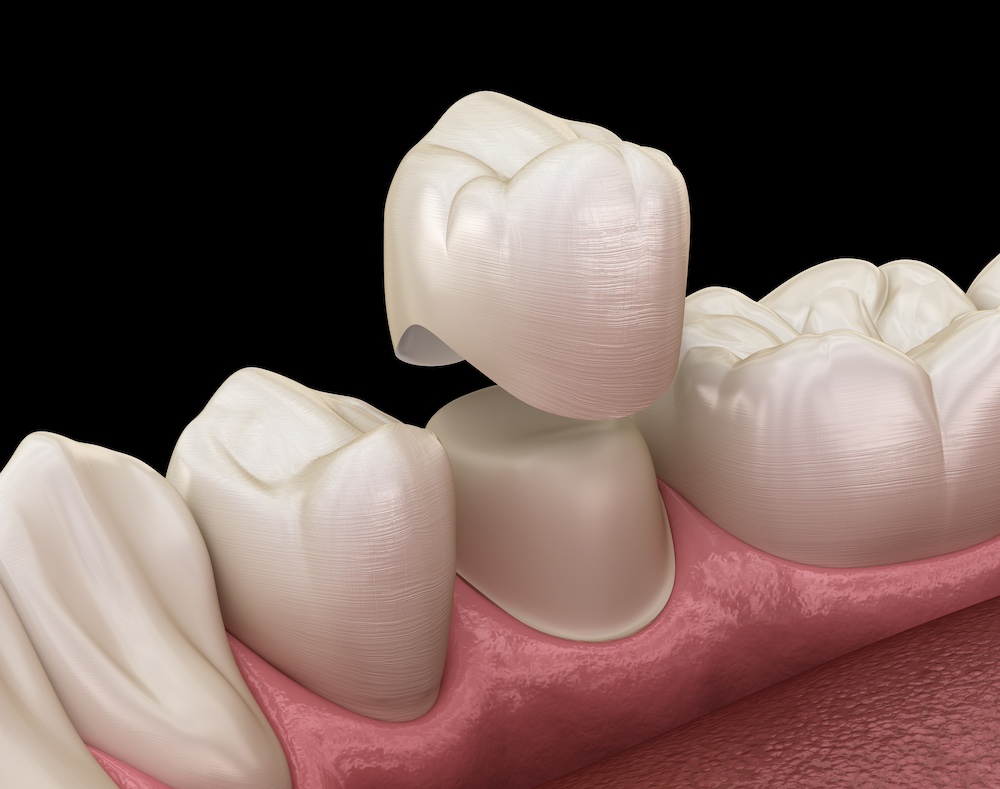Dental crowns are a wonderful option to help save severely damaged teeth. The success and comfort level of crowns hinges on many details, including the amount of healthy natural tooth structure remaining, presence of fractures, proximity to the nerve at the center of the tooth, etc.. When all these details are correctly accounted for, dental crowns enjoy a very high and long lasting success rate.
There are occasional challenges that need to be managed to achieve successful treatment. A quality dentist will be very willing to help a patient they have previously treated manage these issues.
1. Discomfort and Sensitivity
Teeth that need crowns have generally experienced significant damage over time, and then require significant work to treat and save via a crown. Like any other area of the body that has undergone damage, then surgical repair, the teeth will generally go through a period of healing, which generally includes some level of sensitivity.
The closer the damage came to the nerve in the center of the tooth, the higher the probability of sensitivity during the healing phase. This is the most common source of sensitivity, and will generally be managed with anti-inflammatory medication (ibuprofen or equivalent) for a 5-7 day period after the treatment. Patients can expect the sensitivity to temporarily spike, then plateau, the slowly but surely decrease until it is fully gone. This can take from a week to 3 months, depending on the severity of the original damage to the tooth.
Another possible source of sensitivity is how the teeth fit together. Frequently patients have a hard time biting together with full strength when they first receive their new crown. This can lead to a 'high spot' on the new crown that is biting to heavily against the opposite tooth. Your dentist can easily manage this with a slight adjustment.
A third source of potential sensitivity relates to the root surfaces that support the tooth. Root surfaces are less dense and more sensitive then the armored section of the tooth that was originally exposed when your teeth first arrived. Over time bone and tissue loss can expose portions of the root that supports the teeth, and any exposed root surfaces become more sensitive over time as they wear. After crown treatment they can also be a little more sensitive based on the tooth reshaping that is required to successfully crown the tooth. High fluoride tooth pastes (which most people should be using) will generally minimize this within a few months.
2. Chipping or Fracturing
Dental crowns are designed to be durable, but they can still chip or fracture if exposed to excessive force or wear. Common culprits are chewing on hard objects, grinding teeth at night, or using them to open packaging.
If you notice a chipped or fractured crown, your dentist should be contacted immediately to assess the extent of the damage and provide treatment. To avoid another chip or fracture after repair, avoid chewing on hard foods or objects, and wear a nightguard if you’re prone to grinding your teeth while you sleep.
3. Loosening or Falling Off
The most common cause of crowns falling off is new damage (cavity) in the portion of the natural tooth that supports the crown. This can be solved by removing the old crown, removing all the damage, rebuilding the tooth and covering everything with a fresh new crown.
Trauma is also a potential cause of the crown coming loose. Trauma frequently breaks the supporting tooth structure off, and will require a new crown, and possibly a root canal treatment to manage any exposed nerves.
In rare cases, the cement that bonds the crown to the tooth will fail. If this occurs the tooth will be evaluated for health. If it is healthy and the crown still fits, then it can simply be cemented back into place.
It is VERY important to note that once your crown has come free, it is NOT a good idea to try and recement it yourself, even temporarily with short term cements from the drug store. If there is not enough good structure to hold onto the crown, it can come free in your sleep, drop into your airway and cause suffocation. This is called crown aspiration. Don't take the risk.
4. Gum Recession and Crown Margin Exposure
Gum recession occurs when gum tissue is lost due to disease or trauma (hard toothbrushing being the most common cause) and the underlying root surface is exposed. This root surface is darker in color, less dense and more prone to cavities, and can be very sensitive when exposed.
If this softer root surface erodes near the crown margin (connection area of crown and tooth) then bacteria can start pouring in beneath the crown and a cavity will form.
Gentle brushing with a SOFT bristled tooth brush, flossing, and consistently getting cleanings are the best method to minimizing gum recession and the problems that can follow.
If recession has already occurred, have your dentist examine the area to see if any treatment is needed.
5. Allergic Reactions to Crown Materials
Some very old types of crowns (called PFM's) were made with very cheap metals underneath the surface. Cheaper metals can lead to allergic reactions for some people over time in a similar process to how people develop allergies to cheap jewelry. This can lead to symptoms such as gum inflammation, pain, or discomfort.
High quality porcelains DO NOT lead to these types of reactions. New crowns should always be made of these non-allergenic materials, and older crowns with signs of allergic reaction in the surrounding tissues should be replaced.
6. Tooth Decay Underneath the Crown
One of the biggest advantages of dental crowns is their ability to protect and strengthen damaged teeth. However, if oral hygiene is neglected, tooth decay can develop around the edges of the crown which will spread underneath the crown. Left untreated the damage will spread and lead to the loss of the tooth.
In order to avoid this, maintain excellent oral hygiene with regular brushing, flossing, and the use of an antimicrobial mouthwash to prevent decay. Make sure to clean around the crown area thoroughly and consistently. Also, visit your dentist for regular check-ups and cleanings to detect any signs of decay early. Your dentist can take X-rays to check the condition of the tooth underneath the crown. If decay is found, your dentist will need to remove the crown, remove the decay, and place a new crown.
7. Esthetic Issues
Dental crowns are designed to mimic the appearance of natural teeth. However, esthetic issues can arise, such as color mismatch between the crown or discoloration of the crown or adjacent teeth with wear and tear. If you're unhappy with the look of your crown, discuss your concerns with your dentist.
A high quality lab can do an excellent job of blending your new crown to match the adjacent teeth. Make certain that your dentist asks for your input regarding your satisfaction with the color match BEFORE it is cemented in place. Your satisfaction is KEY to the process being a success.
Dental crowns are a common and valuable dental procedure that can restore the function and appearance of damaged teeth. However, they aren’t without potential challenges. By maintaining good oral hygiene, seeking prompt dental care when issues arise, and following your dentist's recommendations, you can address and prevent many common dental crown problems. Regular communication with your dentist is the key to ensuring the longevity and success of your dental crown.
We would love the opportunity to serve you! Please reach out to us at Daniel Appel DDS, (530) 533-7545 if you need a caring dental team!



